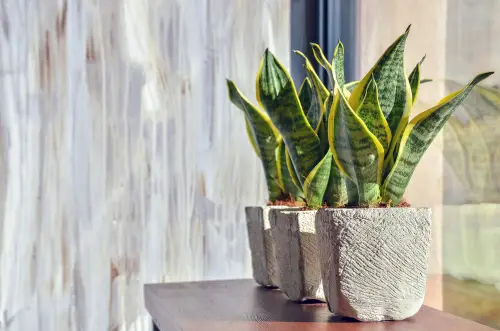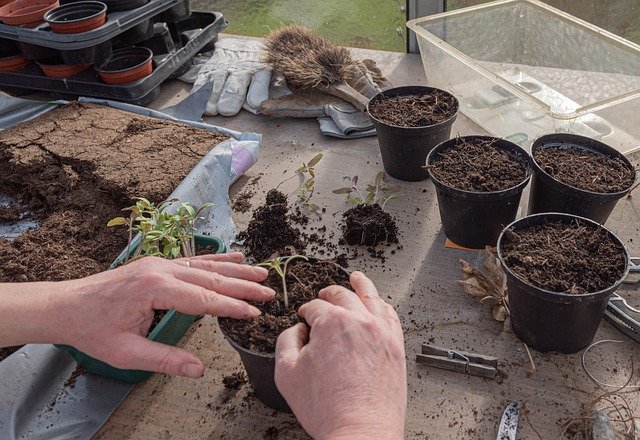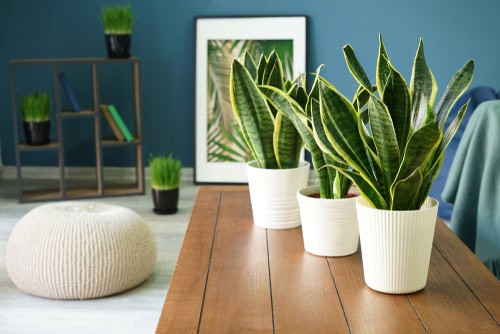Snake plants are popular houseplants that are known for their easy care and air-purifying qualities. However, sometimes snake plants can start growing sideways, which can be a cause of concern for plant owners. Understanding why a snake plant is growing sideways is important in preventing and correcting this issue.
There are several reasons why a snake plant may start growing sideways. One common reason is a lack of sunlight. Snake plants require bright, indirect light to grow properly, and if they are not receiving enough light, they may start to grow towards the light source, which can result in sideways growth.
Additionally, snake plants may start growing sideways if they are planted in bad soil or over-fertilized soil.
Preventing snake plant growing sideways is possible by providing them with the right growing conditions. This includes ensuring that they are planted in well-draining soil, avoiding over-fertilization, and providing them with adequate light.
Correcting sideways growth in snake plants may require some pruning and repositioning of the plant to ensure that it is growing upright.
More on this category:
- Why Is My Snake Plant Getting Soft?
- Why Is My Snake Plant Getting Mushy?
- Why Is My Purple Passion Plant Wilting?
Understanding Snake Plant Growth

Snake plants are a popular choice for indoor plants due to their easy care and air-purifying properties. However, sometimes they can grow sideways, which can be a cause for concern. Understanding snake plant growth can help you identify why your plant is growing sideways and how to fix it.
Phototropism and Snake Plants
Phototropism is the growth movement of plants in response to light. Snake plants exhibit positive phototropism, which means they grow towards the light source. If your snake plant is growing sideways, it may be because it is not receiving enough light on one side.
To fix this, move your plant to a brighter location or rotate it regularly to ensure all sides receive equal light. It’s important to note that snake plants can tolerate low light conditions, but they will grow slower and may become leggy if they don’t receive enough light.
Growth Seasons and Snake Plants
Snake plants are slow-growing plants, and their growth rate can vary depending on the season. They typically grow more during the spring and summer months when temperatures are warmer and there is more sunlight. During the fall and winter months, they may grow less or even go dormant.
If your snake plant is growing sideways during the fall or winter months, it may be because it is going dormant. In this case, it’s best to leave the plant be and not try to force growth. Once the spring arrives and the plant begins to grow again, it should start growing upright.
Why Is My Snake Plant Growing Sideways – 6 Common Problems
Snake plants are known for their upright, sword-like leaves that can grow up to several feet tall. However, sometimes they may start growing sideways instead of remaining upright. Here are some possible reasons why this might happen:
1. Insufficient Light
One of the most common reasons for sideways growth in snake plants is insufficient light. These plants require bright, indirect light to grow well. If they are not getting enough light, they will start to grow towards the light source, which can result in sideways growth.
To fix this issue, move the plant to a brighter location or provide it with a grow light.
2. Overwatering or Underwatering

Another common cause of sideways growth is overwatering or underwatering. Snake plants prefer well-draining soil that is allowed to dry out between waterings.
If the soil is too dense or the plant is overwatered, it can lead to root rot, which can cause the plant to start falling over or growing sideways. On the other hand, if the plant is underwatered, the leaves may start to bend or curl.
3. Poor Soil Quality
Snake plants require well-draining soil that is rich in nutrients. If the soil is poor quality or lacking in nutrients, it can cause the plant to grow poorly or become top-heavy, leading to sideways growth. To fix this issue, use a well-draining soil mix that is high in nitrogen, phosphorus, and potassium.
4. Pest Infestation
Pests such as spider mites and mealybugs can cause damage to the leaves and root structure of snake plants, which can lead to sideways growth. If you notice any signs of pest infestation, such as yellow leaves or sap on the plant, take immediate action to treat the issue.
5. Lack of Support
If the snake plant is not supported properly, it may start to grow sideways or fall over. This can happen if the plant is top-heavy or if it is neglected for too long. To prevent this issue, use garden stakes, string, or twine to support the plant as it grows.
6. Pot-Bound
If the snake plant has outgrown its container, it may start to grow sideways or become top-heavy. To fix this issue, transplant the plant into a larger container with fresh soil and provide it with adequate support.
Preventing Sideways Growth in Snake Plants
Snake plants are popular houseplants that are easy to care for and can add a touch of greenery to any indoor space. However, if you notice your snake plant growing sideways, it could be a sign of a problem that needs to be addressed. Here are some tips to prevent sideways growth in your snake plant.
1. Proper Watering Techniques
Overwatering or underwatering can both lead to problems with your snake plant, including sideways growth. It is important to water your snake plant only when the top inch of soil is dry to the touch.
When watering, be sure to thoroughly saturate the soil and allow any excess water to drain away. Avoid letting your snake plant sit in standing water, as this can lead to root rot.
2. Appropriate Lighting

Snake plants prefer bright, indirect light, but they can also tolerate lower light conditions. If your snake plant is growing sideways, it may be reaching for a light source.
Make sure your snake plant is placed in a spot with adequate lighting, such as a south-facing window. If your snake plant is not getting enough light, consider using a grow light to supplement its lighting needs.
3. Soil and Drainage
Snake plants require well-draining soil to prevent root rot and other issues. Make sure your snake plant is planted in a well-draining soil mix and that the pot has adequate drainage holes.
If your snake plant is growing sideways due to a lack of support, consider staking it with a garden stake or repotting it into a larger container with a sturdy stake for support.
4. Repotting and Support
If your snake plant is growing sideways due to a cramped root structure, it may be time to repot it into a larger container. When repotting, be sure to use a well-draining soil mix and a pot with adequate drainage holes. You can also stake your snake plant for support using a garden stake or other support structure.
5. Pest Control
Pests such as spider mites and mealybugs can cause problems with your snake plant, including sideways growth. Keep an eye out for any signs of pest infestation, such as webbing or white cottony masses on the leaves. If you notice any pests, treat your snake plant with an appropriate pesticide or insecticidal soap.
By following these tips, you can help prevent sideways growth in your snake plant and keep it healthy and thriving. Remember to provide your snake plant with appropriate care, including proper watering, lighting, and soil conditions, and keep an eye out for any signs of pests or diseases.
Correcting Sideways Growth in Snake Plants
Snake plants are a great addition to any houseplant collection, but sometimes they can start growing sideways. This can be caused by a variety of factors such as lighting conditions, watering, soil, pests, and more. Luckily, there are several ways to correct sideways growth in snake plants.
1. Staking and Twining
One way to correct sideways growth in snake plants is by providing support. Staking and twining are two methods that can help straighten out the plant. Garden stakes or bamboo sticks can be inserted into the soil next to the plant and then gently tied to the stem.
Alternatively, twining the plant around a support structure can help straighten it out and promote upright growth.
2. Adjusting Watering and Lighting
Another factor that can cause sideways growth in snake plants is improper watering and lighting conditions. Snake plants prefer well-draining soil and should not be overwatered. They also prefer bright, indirect light but can tolerate low light conditions.
If the plant is not receiving enough light, it may start to grow sideways in an attempt to reach the light source. Adjusting watering and lighting conditions can help promote upright growth.
3. Repotting and Soil Adjustment

If the snake plant is growing sideways due to root structure issues or soil problems, repotting may be necessary. Repotting the plant into a larger container with well-draining soil can help correct any root issues or soil problems that may be causing sideways growth.
4. Treating Pest Infestations
Pests such as spider mites and mealybugs can also cause sideways growth in snake plants. If the plant is infested with pests, it is important to treat the infestation as soon as possible to prevent further damage. Insecticidal soap or neem oil can be used to treat the infestation and promote upright growth.
5. Pruning and Propagation
If the snake plant has become too leggy or top-heavy, pruning may be necessary to promote upright growth. Pruning back the plant can help redirect growth and promote a more upright structure. Additionally, propagating the plant can help promote new growth and a more upright structure.
Frequently Asked Questions
How can I fix a leaning snake plant?
If your snake plant is leaning to one side, it could be due to insufficient light. Move the plant to a brighter location, preferably near a window where it can receive indirect sunlight.
Alternatively, you can rotate the plant regularly to ensure that all sides receive equal light. Another possible cause of a leaning snake plant is root rot, which can be fixed by repotting the plant in fresh, well-draining soil.
What is the best way to prune a snake plant?
Pruning a snake plant is relatively easy. Simply use a sharp, clean pair of scissors or pruning shears to cut off any dead or damaged leaves at the base of the plant.
You can also remove any leaves that are yellowing or drooping. Be sure to disinfect your tools before and after use to prevent the spread of disease.
Why is my snake plant growing unevenly?
If your snake plant is growing unevenly, it could be due to a lack of nutrients. Consider fertilizing your plant with a balanced, all-purpose fertilizer to promote healthy growth.
Another possible cause of uneven growth is improper watering. Be sure to water your snake plant only when the top inch of soil is dry to the touch.
Should I cut off drooping leaves from my snake plant?
If your snake plant has drooping leaves, it could be a sign of overwatering or root rot. In this case, it’s best to cut off the affected leaves at the base of the plant to prevent the spread of disease.
However, if the drooping is due to a lack of water, simply watering the plant should help the leaves perk up.
How can I make my snake plant grow straight?
To encourage your snake plant to grow straight, make sure it’s getting enough light. Rotate the plant regularly to ensure that all sides receive equal light. You can also use stakes or supports to prop up the plant and encourage it to grow upright.
What causes a snake plant to lean to the side?
A snake plant may lean to one side if it’s not getting enough light. Alternatively, it could be due to root rot, which can cause the plant to become unstable. In some cases, a leaning snake plant may simply be the result of natural growth patterns.

Hey, I’m Lisa and I’ve been an avid gardener for over 30 years. I love writing, talking and living in the garden! Feel free to connect with me on my socials below


